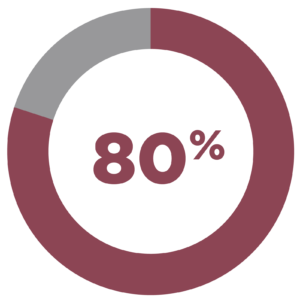Roadmap for Renewing Our Federal Government
Innovation and Technology Modernization
THE CHALLENGE
Our country needs an effective, innovative government that can meet the demands of a fast-paced, interconnected, technology-driven world, but government often struggles to keep pace. Federal agencies offer few incentives for employees to try new ideas, are saddled with outdated technology and lag behind the private sector in hiring qualified technologists in sufficient numbers for critical leadership and staff positions. This antiquated system is an impediment to the government’s ability to meet the needs of today’s interconnected, technology-driven world and prepare for the challenges of the future.

Just over four in 10 federal civil servants feel creativity and innovation are rewarded in the workplace, according to 2019 Best Places to Work in the Federal Government® data.

The government spends 80% of its annual $100 billion information technology budget on operating and maintaining existing IT investments, including legacy systems—many of which are decades old—not on new investments in leading-edge technologies.

There are 16 times more mission-critical IT employees age 50 and over than under 30 (52.5% versus 3.3%).

The federal government ranked last among 10 major economic sectors in customer satisfaction, falling short on the timeliness and ease of its processes, professionalism, courtesy, and website quality, according to the 2019 American Customer Satisfaction Index.
RECOMMENDATIONS FOR CONGRESS
Short-term spending resolutions and government shutdowns impede agencies from engaging in long-term planning and investments, like replacing or modernizing antiquated IT systems.
Technologies have evolved rapidly since the adoption of laws such as the Clinger-Cohen Act of 1996 and the E-Government Act of 2002, but the framework for how the government acquires and manages technology has not kept pace with today’s needs. Modernizing the technology laws and practices will help bring the government in sync with today’s fast-paced digital economy, competitive labor market and evolving customer expectations.
The public deserves user-friendly services from the federal government, and the importance of providing fast and reliable services reached new heights during the coronavirus pandemic. Passing the FACE Act would revise an outdated law that makes it difficult to collect and publish customer experience data and that will allow agencies to collect that feedback and engage in conversations with their customers.
RECOMMENDATIONS FOR THE BIDEN ADMINISTRATION
Government needs a customer experience “moonshot” – a bold target that, if achieved, would demonstrate that agencies can deliver modern services that meet public needs and expectations. A customer focus will help agencies meet rising expectations and accomplish their missions as well as improve trust in government, which stands near an all-time low.
The coronavirus pandemic demonstrated that technology is at the center of government’s ability to operate efficiently and deliver services. Outlining the steps, resources and roles essential to upgrade technology, while providing flexibility for agencies based on the technology needs of their employees and customers, will help government adapt to rapidly changing demands. Political and career leaders should also have a basic familiarity with technology and cybersecurity issues in order to focus on key priorities and make informed choices across all policy areas.
In 2018, the Office of Management and Budget published guidance for how government’s 25 highest impact services should manage, measure and report on the customer experience. The country will be better served by expanding this guidance to additional government service providers, whether they interact directly with the public or provide internal mission-support services.
RECOMMENDATIONS FOR FEDERAL AGENCIES
By soliciting, selecting and funding proposals that emanate from employees with firsthand knowledge of how their agencies operate, the government can improve the impact and cost-effectiveness of initiatives and programs. Challenge.gov houses extensive resources for developing and running challenges and prize competitions.
A corps of acquisition workforce members who are empowered to be internal consultants and coaches could improve government’s often burdensome procurement process by supporting agency acquisition teams on specific procurements. The Procurement Innovation Lab within the Department of Homeland Security serves as a successful model as does the Digital IT Acquisition Professional Program, which trains acquisition specialists on designing innovative and flexible procurements.
Some populations face barriers accessing federal services, limiting the scope and effectiveness of federal programs. The implementation of Executive Order 13985 will help agencies understand and address the issues that underserved communities may face, including lack of internet access, language barriers and cultural considerations. Agencies also will be able to share best practices in reaching underserved people as part of cross-agency customer experience work.